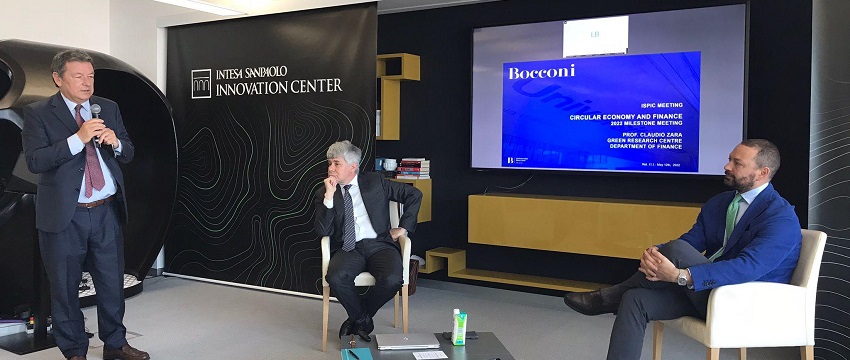Research on CE and de-risking by Bocconi University, Intesa Sanpaolo and Ellen Macarthur Foundation presented at the 31st floor


Professor Zara shared the results achieved by the Circular Economy for a comparison with the next objectives
Intesa Sanpaolo and Intesa Sanpaolo Innovation Center have always stood out in their commitment to the Circular Economy, a commitment they carry out through numerous initiatives and partnerships. Among these, the collaboration with Bocconi University and Ellen MacArthur Foundation produced The Circular Economy as a de-risking strategy and driver of superior risk-adjusted returns, a paper also cited on the European Circular Economy Stakeholder Platform.
Claudio Zara, professor at Bocconi University, presented the research described in the paper at the Intesa Sanpaolo Innovation Center in Turin.
It was an opportunity to deepen the economic importance of the Circular Economy in the current scenario, to retrace the path that Intesa Sanpaolo and Bocconi University have taken together in recent years and to discuss future commitments.
The paradigm of the Circular Economy and the contribution of Intesa Sanpaolo
Maurizio Montagnese - President of Intesa Sanpaolo Innovation Center opened the meeting by underlining how the Circular Economy is not just a set of initiatives to be implemented in companies to reach a higher level of sustainability, but a development paradigm that leads to the adoption of models of new production.
Intesa Sanpaolo is alongside companies to help them achieve these objectives with numerous credit instruments, such as the Circular Economy Plafond, 8 billion made available to companies that adopt the circular model with innovative methods, and the Green Bond focused on CE, an issue from 750 million.
However, these incentives are not sufficient because the transition to a Circular Economy requires companies to be involved in the transformation process. Intesa Sanpaolo Innovation Center makes its contribution in this sense thanks to the Circular Economy Lab, which is responsible for supporting the circular transformation of companies and SMEs thanks to advisory services and Open Innovation programs.
Research by Bocconi University, Ellen MacArthur Foundation and Intesa Sanpaolo
The paper The Circular Economy as a de-risking strategy and driver of superior risk-adjusted returns represents an example of how the Circular Economy is a resource for companies and for the economic system in general.
Investing in the circular economy also generates superior performance thanks to the acquisition of a systemic vision of production processes and the use of innovative tools.
In his speech, Professor Claudio Zara briefly summarized the research that involved 222 companies active in 14 sectors and demonstrated that a higher level of circularity of a company corresponds to a lower risk of debt insolvency in a short time horizon ( 1 year) or medium-long (5 years).
